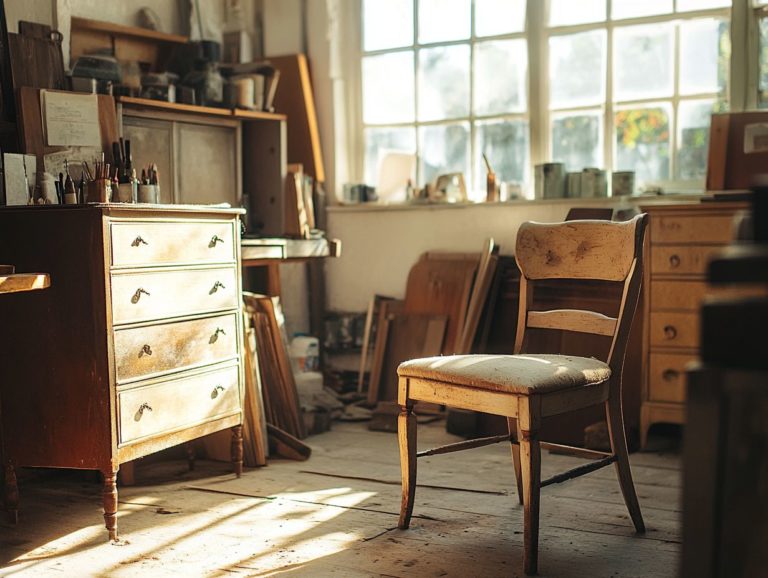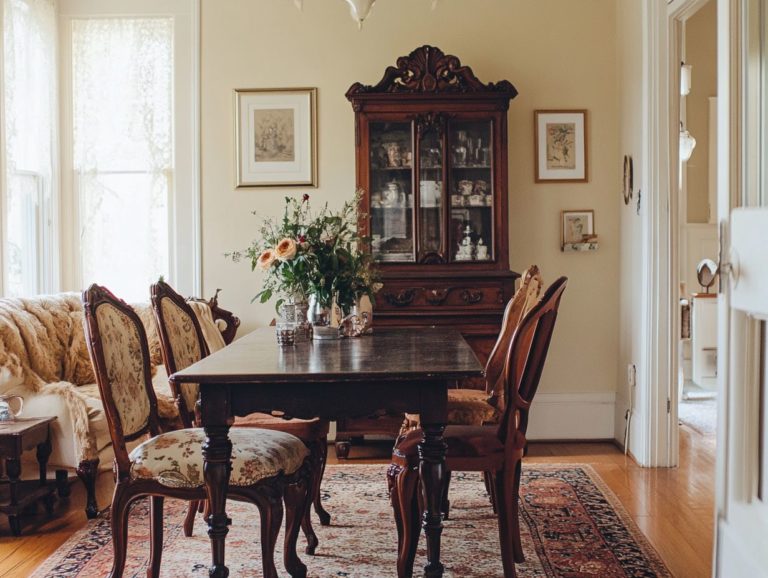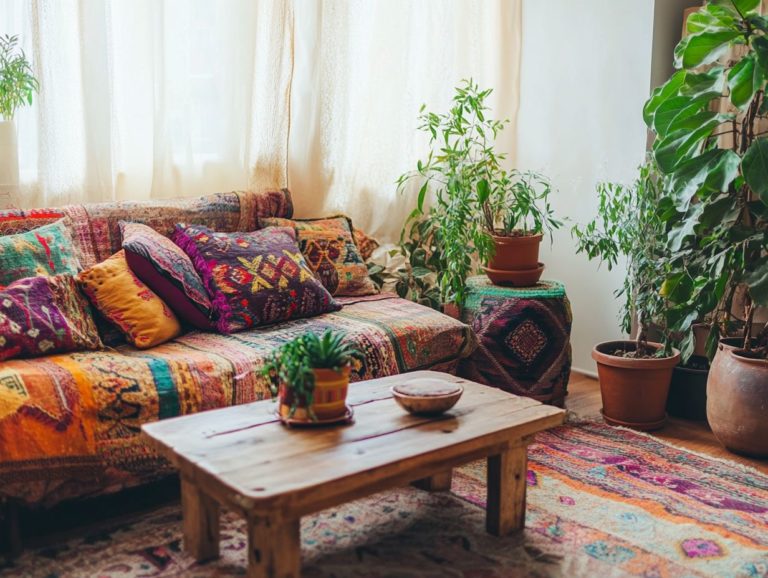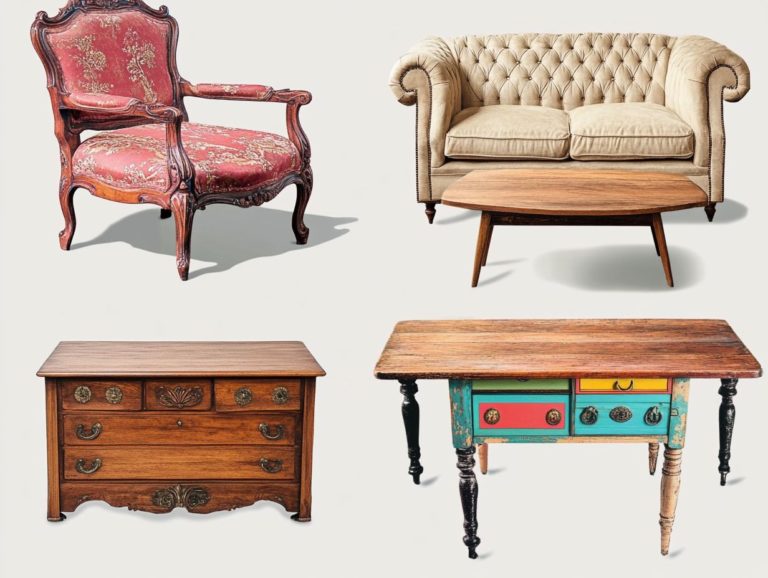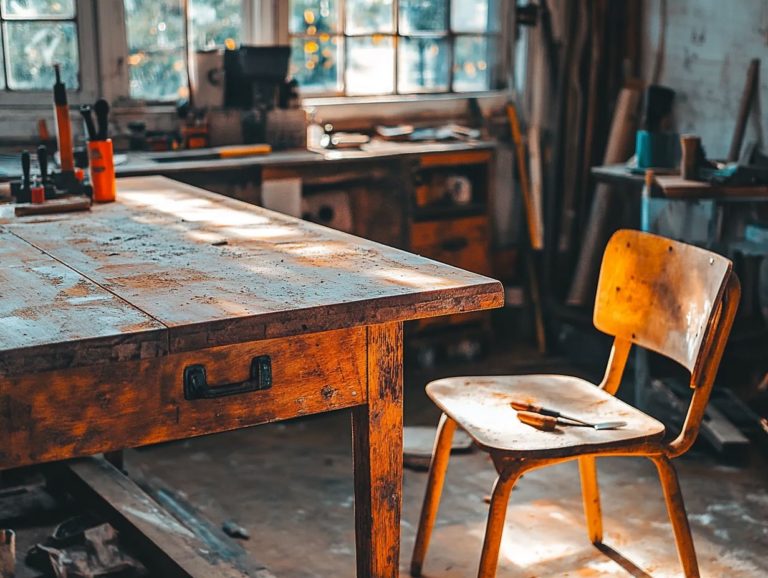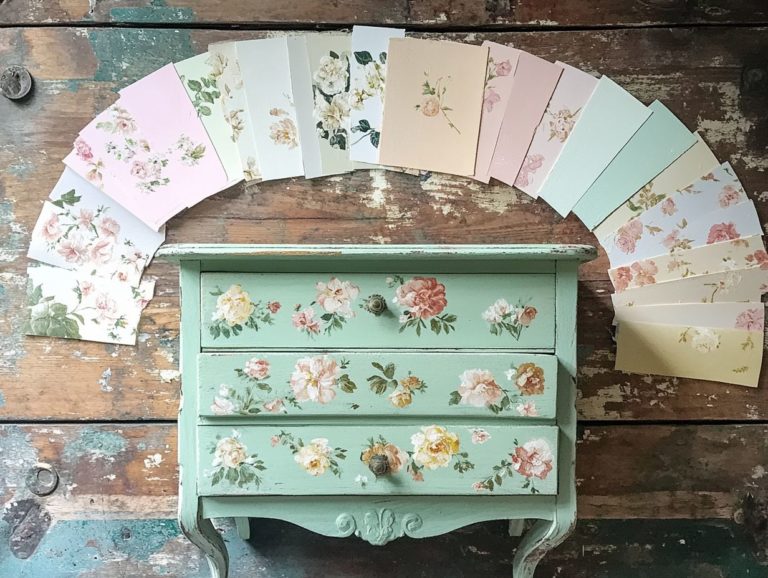Understanding Different Types of Vintage Furniture Fabrics
Vintage furniture fabrics infuse any space with character and charm. But what truly defines a fabric as “vintage textiles”?
This exploration delves into the essence of vintage textiles, including varieties like barkcloth fabric, and showcases popular options such as cotton, wool, silk, velvet, and leather.
You ll uncover how to recognize signs of wear and learn the best practices for caring for these timeless treasures.
Discover innovative ways to integrate vintage fabrics into modern design, like art deco furniture and mid-century modern styling. This will allow your decor to narrate a captivating story of the past.
Contents
- Key Takeaways:
- Common Types of Vintage Furniture Fabrics
- How to Identify and Care for Vintage Furniture Fabrics
- Using Vintage Fabrics in Modern Design
- Frequently Asked Questions
- What are some common types of vintage furniture fabrics?
- What is the difference between velvet and brocade fabrics?
- LET’S EXPLORE SOME POPULAR VINTAGE FABRICS AND HOW TO CARE FOR THEM
- HOW CAN I IDENTIFY CHINTZ FABRIC?
- WHAT IS THE BEST WAY TO CARE FOR DAMASK FABRIC?
- WHY IS LINEN A POPULAR FABRIC FOR VINTAGE FURNITURE?
- CAN I REUPHOLSTER VINTAGE FURNITURE WITH SILK FABRIC?
Key Takeaways:

- Cotton, wool, silk, velvet, and leather bring unique charm and care needs to vintage furniture.
- Recognizing signs of wear, like fading and fraying, helps you identify and maintain vintage fabrics.
- With thoughtful integration, vintage fabrics can add stunning character to modern spaces.
What Makes a Fabric ‘Vintage’?
A fabric is considered ‘vintage’ when it captures the essence of past design eras, often tracing back to the mid-20th century, influenced by mid-century modern, art deco, and Scandinavian design. Vintage textiles, such as barkcloth (a type of fabric made from tree bark) and heirloom upholstery, exhibit a unique craftsmanship history that highlights the use of luxurious materials and natural fibers, setting them apart from today’s contemporary options.
By understanding the distinctive characteristics of vintage fabrics, including beautiful patterns that catch the eye and geometric designs, you’ll marvel at their rich history and unique beauty. For insights on the styles of vintage furniture by era, explore how these elements contribute to the overall charm of vintage decor.
These fabrics often boast intricate details and bold geometric patterns, echoing the innovative styles of iconic designers like Charles Eames, Arne Jacobsen, and George Nelson, as well as Oscar de la Renta, who transformed fabric design in their eras. These textiles aren’t just nostalgic; they promote sustainability by giving high-quality materials a second life.
Vintage fabrics whisper stories of a bygone era while offering a unique retro aesthetic and clean lines that can elevate modern spaces, making them not just a sustainable choice but also a striking fashion statement.
Common Types of Vintage Furniture Fabrics
Vintage furniture fabrics encompass an exquisite array of materials, including textured and sheer fabrics, each imparting its own distinct texture and visual appeal to classic designs.
Among the most notable are:
- Cotton, celebrated for its durability;
- Wool, which envelops with warmth;
- Silk, adding a luxurious touch;
- Velvet, renowned for its sumptuous texture;
- Leather, embodying sophistication.
Each fabric contributes its unique aesthetic to vintage pieces, enabling you, as a collector or designer, to make informed choices among upholstery and designer fabrics that perfectly align with your creative vision, including boucle and charmeuse. Understanding the value of vintage furniture can further enhance your selections.
Cotton
Cotton is a remarkably versatile textile that finds its place in vintage furnishings, admired for its breathability and adaptability. It is truly a staple in upholstery fabrics and is often used alongside crepe and brocade.
This natural fiber carries a rich historical significance, tracing its roots back to ancient civilizations that cherished it for its comfort and durability, similar to that of damask and jacquard. In the realm of vintage textiles, cotton demonstrates its timeless appeal across various furniture styles, particularly in mid-century modern and art deco design, showcasing clean lines and iconic shapes. For those interested in the intricate details of vintage pieces, understanding the craftsmanship of vintage furniture can enhance appreciation for these designs.
These movements often embraced bold decorative motifs and geometric patterns, perfectly complemented by cotton s capacity to retain vibrant colors and intricate designs.
The softness of this fabric elevates the tactile experience of furniture, inviting you to indulge in both aesthetic pleasure and functional comfort while relishing the vintage charm of eras gone by.
Wool
Wool is highly valued in vintage textiles for its remarkable warmth and resilience. It often graces heirloom upholstery and sustainable materials that withstand the test of time.
This natural fiber doesn t just offer exceptional durability; it also makes vintage furniture look better. Wool adds a unique character and charm, especially when paired with soft silk.
Across various design movements be it Arts and Crafts or Mid-Century Modern wool has played a vital role. It provides texture and depth that seamlessly integrates with other luxurious materials like soft silk.
The interplay of these fabrics creates an inviting atmosphere. This setting is ideal for both traditional and contemporary interiors, fostering comfort while elevating the overall design.
By incorporating wool into retro pieces, you ensure they remain functional and stylish. This strikes a harmonious balance between practicality and flair, complementing the textured fabrics used in vintage design.
Silk

Silk isn t just a fabric; it s a luxurious experience that elevates vintage textiles to a whole new level, especially when crafted into lightweight, sheer chiffon or soft, shiny charmeuse. Its elegant drape and smooth finish make it the go-to choice for high-end upholstery, often paired with decorative motifs and brocade.
Silk weaving techniques began in ancient China and spread west along the Silk Road. This heritage of craftsmanship highlights the material’s inherent value and enhances the beauty of vintage furniture pieces.
Silk complements ornate detailing effortlessly, shining in both subtle and bold designs. It echoes the retro aesthetics that many hold dear in vintage textiles like duchess and dupioni.
Silk s shiny surface catches the light, adding depth and making vintage furniture truly stand out. This fabric bridges modern audiences with the rich tapestry of history and artistry, reminiscent of Victorian furniture craftsmanship.
Velvet
Velvet is a plush fabric that adds sophistication to vintage textiles. It effortlessly evokes retro aesthetics and luxurious interiors.
Originally woven from silk, velvet has a rich history that traces back to ancient cultures. It is cherished for its soft texture and regal appearance.
This fabric bridges the gap between past and present, making it an enduring favorite in contemporary design. Velvet is often featured in Scandinavian design styles.
Its versatility shines in both classic and modern settings, whether you re considering a sumptuous sofa or decorative cushions. Iconic furniture pieces, like the mid-century modern Eero Saarinen Tulip chair or the Victorian tufted armchair, often showcase velvet s magnetic allure.
Velvet pairs beautifully with other materials, such as leather and linen, elevating the overall aesthetic of any space you choose to adorn.
Leather
Leather stands as a timeless material in the realm of vintage textiles. It is admired for its durability and classic charm, frequently showcased in iconic furniture designs like those by Charles Eames and George Nelson.
When you integrate leather into your furniture, it brings a sense of richness and enhances the overall character of the piece. This makes it a favored choice among renowned designers.
Take, for example, the legendary Charles and Ray Eames, who masterfully incorporated leather into their Lounge Chair. They harmonized comfort with sophisticated aesthetics.
To maintain leather’s natural luster and ensure its longevity, commit to regular conditioning, meticulous cleaning, and awareness of wear patterns. This will help maintain its appeal in vintage textiles.
Leather beautifully complements a variety of design styles. It ranges from the sleek minimalism of Scandinavian interiors to the inviting warmth of mid-century modern decor, where its texture can soften stark lines and create a more welcome atmosphere.
Explore these fabrics to elevate your vintage decor today!
How to Identify and Care for Vintage Furniture Fabrics
Identifying vintage furniture fabrics is crucial. You need to recognize signs of wear and tear and know cleaning methods that maintain their integrity.
Vintage textiles, such as silk and velvet, need special care. This attention helps keep them in excellent condition.
Signs of Wear and Tear
Signs of wear and tear in vintage textiles reveal themselves through fading colors, fraying edges, and a loss of texture. These issues can detract from the elegance of your upholstery fabrics.
Recognizing these indicators early is essential for preserving your cherished pieces. For example, cotton may develop thinning areas or tiny holes, while silk often becomes dull and brittle, making it more prone to tearing.
Velvet, with its luxurious feel, can lose its signature softness and luster, leading to unsightly matted patches. By closely examining your fabrics and observing these subtle changes, you can take proactive steps such as gentle cleaning or minor repairs before more extensive damage sets in.
Cleaning and Maintenance Tips

Effective cleaning and maintenance of vintage textiles are essential for keeping them looking good for years. Different fabrics require specific techniques for optimal care.
This care is vital for your sentimental treasures. Don t let them fade away! For delicate silks, wash by hand gently in cool water with a mild detergent. Cotton can usually handle a machine wash on a delicate cycle.
Wool requires special attention avoid harsh detergents to protect its natural oils. Regular dusting and careful storage away from direct sunlight and extreme humidity are also important for maintaining your cherished textiles.
Using Vintage Fabrics in Modern Design
Incorporating vintage fabrics into your modern designs creates a seamless fusion of past and present. This approach enriches your contemporary spaces with unique character and a rich history.
When executed thoughtfully, the right combination can elevate your modern aesthetic while paying homage to the artistry of craftsmanship history.
Incorporating Vintage Pieces into Contemporary Spaces
Incorporating vintage pieces into your contemporary spaces can create stunning focal points. This creates a bridge between styles such as mid-century modern and Scandinavian design to elevate your interiors.
By thoughtfully selecting textiles or furniture that resonate with your existing elements, you can craft a harmonious environment that beautifully blends the past with the present. Consider playful color palettes that merge muted tones with vibrant accents, allowing the distinctive character of your vintage items to shine through.
Strategic layout choices can highlight the unique shapes and intricate patterns of these pieces. Positioning them to either contrast or complement their modern counterparts enhances visual interest and invites exploration.
Ultimately, this creative interplay ensures a cohesive narrative that reflects your personal style, making your space truly one-of-a-kind.
Frequently Asked Questions
What are some common types of vintage furniture fabrics?
Some common types of vintage furniture fabrics include velvet, brocade, chintz, damask, linen, and silk.
What is the difference between velvet and brocade fabrics?

Velvet is a soft, plush fabric made of silk, cotton, or synthetic fibers. Brocade, on the other hand, is a rich, decorative fabric with raised patterns made of silk, cotton, or metallic threads.
LET’S EXPLORE SOME POPULAR VINTAGE FABRICS AND HOW TO CARE FOR THEM
HOW CAN I IDENTIFY CHINTZ FABRIC?
Chintz fabric is typically made of cotton or a cotton blend. It features a glazed finish with brightly colored floral patterns.
This fabric is often used for upholstery and drapery in vintage furniture.
WHAT IS THE BEST WAY TO CARE FOR DAMASK FABRIC?
Damask fabric has raised patterns that are created by weaving threads together. It should be dry cleaned or spot cleaned gently with mild detergent and warm water.
Avoid using harsh chemicals or scrubbing the fabric too vigorously.
WHY IS LINEN A POPULAR FABRIC FOR VINTAGE FURNITURE?
Linen is a strong and durable fabric made from flax plant fibers.
It is resistant to fading and wear, making it an excellent choice for vintage furniture that must endure years of use.
CAN I REUPHOLSTER VINTAGE FURNITURE WITH SILK FABRIC?
Silk fabric can be used for reupholstering vintage furniture. It’s a beautiful but delicate fabric that deserves special care.
Ready to give your vintage furniture a fresh look? Start by choosing the right fabric today!
Explore more about vintage fabrics and make your home’s decor stand out!

